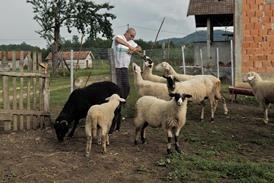UPDATED & EXCLUSIVE: Beta closes a number of key deals on Venice award-winner Still Life.
Still Life director Uberto Pasolini has several new projects on the boil as a producer through his company Redwave. One is a UK/French comedy that is being co-scripted by Simon Nye and that he will make with Rita Dagher’s Senorita Films. Another is a British comedy written by comedian Deborah Frances-White. Meanwhile, he is still working with director Alan Taylor (Palookaville, Thor) on The Horseman, a western adapted from David Anthony Durham’s civil war set novel, Gabriel’s Story.
He is also hatching a version of The Odyssey from a script by Edward Bond. (Pasolini nearly made the project a decade ago with Neil Jordan and is re-firing it now.)
Meanwhile, Beta has sold Still Life to BIM for Italy, Wild Bunch for Benelux, Palace in Australia, Filmcoopi in Switzerland, Arthaus in Norway, Folkets Bio in Sweden, and Feelgood in Greece. Offers are on the table for France, Spain, Germany and the UK.
Pasolini first had the idea for Still Life, which won him the Orizzonti Best Director Award in Venice, when he read a newspaper story about British council workers whose job was to find the next of kin of those who died alone.
The elegiac comedy-drama stars Eddie Marsan as council funeral officer John May.
“Very accurate!” Pasolini exclaims when asked how true to life (and death) his film really is. The writer-director spent “many days” with council officers in Lewisham and Southwark who deal with unclaimed bodies.
“They (the council officers) try to contact the relatives of people who have died alone. In the absence of that, they are charged with organising the funerals. This goes for people who might be found dead in private accommodation, in council accommodation, in buses, in the street, really anywhere.”
In 70% of the cases, no next of kin can be found. Even when relatives are tracked down, they often don’t want to have anything to do with the dead person. Pasolini offers a grim picture of “thousands and thousands of funerals every year in the UK attended by nobody.” He suggests that this is “enormously indicative” of contemporary society. Ties between families and communities have become ever looser. Certain unfortunate people are forgotten and ignored in death as they have been in life. In most cases, council officers are too busy to go to the funerals they themselves arrange. In Pasolini’s film, though, Marsan’s character makes it a point of principle that he will attend as many funerals as he can. He also writes eulogies for the dead in a bid to give them at least a trace of dignity and recognition.
The shooting style in Still Life is restrained (and very different from that of the Pasolini-produced box-office hit The Full Monty.) Early on, the colours are dull and desaturated. Only slowly does the film become brighter and more vibrant.
“I told the director of photography never to move the camera!” Pasolini says of the tableau-style effect he was pursuing. The stillness reflects “the life of the central character…his own life is not moving, not engaging, except with his clients.” The inspiration for his quiet, understated approach came from the great Japanese director, Ysaujiro Ozu. “It’s funny how much work you have to do to achieve that simplicity as opposed to the energy of a moving camera or a handheld camera.”
As for The Full Monty, “it is still feeding me” Pasolini jokes of the comedy about male strippers that proved a worldwide hit.
























No comments yet